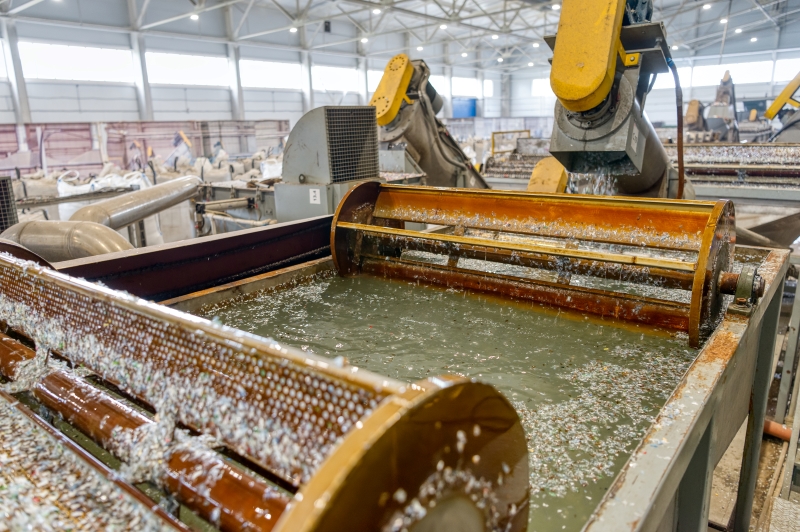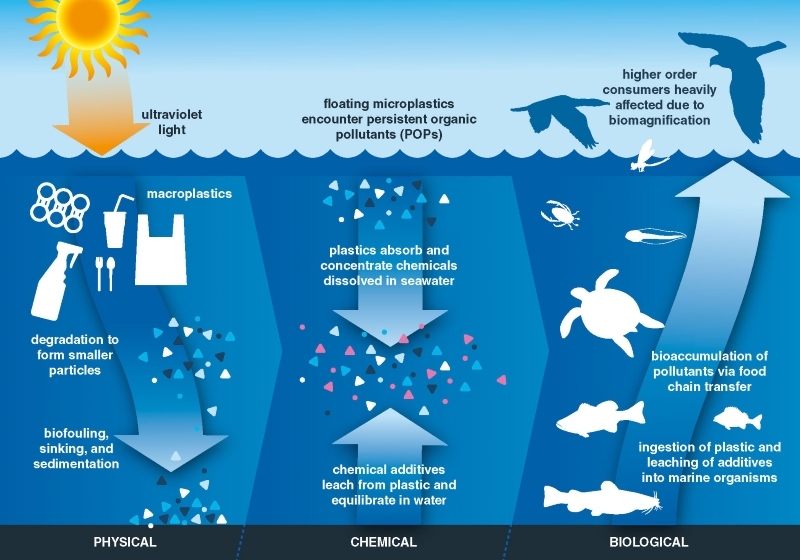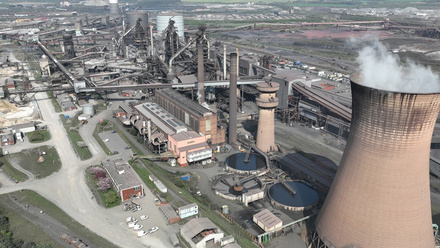Mitigating microplastics
The increasing risk of micro- and nanoplastics emissions from plastics recycling.

Much has been written about microplastics in recent decades as they proliferate across all aquatic and terrestrial eco-systems, posing profound ecological and human health risks.
Microplastics originate from various sources, including the breakdown of larger plastic debris, synthetic fibres from textile manufacturing and washing machines, microbeads in personal care products, and industrial processes including the plastics recycling sector.
Present findings show higher environmental degradation rates in recycled plastics than virgin ones. A further source of microplastics, one driven by climate change, is the polar ice cap melting, releasing previously sequestered microplastics.
Particles can be transported between terrestrial, freshwater and marine ecosystems through the atmosphere, currents, waterways and overland run-off. They persist in the environment due to their resistance to degradation, accumulating in soil, water bodies and even the atmosphere.
Moreover, microplastics (including their biofilms) serve as vectors for harmful chemicals, such as persistent (and bio-accumulative) organic pollutants, exacerbating their effects on ingestion.
They pose a particularly acute threat to aquatic ecosystems, where they infiltrate marine and freshwater environments, endangering diverse organisms at all trophic levels, from zooplankton to apex predators, leading to bioaccumulation and biomagnification along the food chain.
Terrestrial ecosystems are also affected, with soils showing increasing microplastic pollution, and earthworms and microorganisms crucial for nutrient cycling known to be at risk.
The widespread use of plastic covers in agriculture, the breakdown of plastic litter and the deposition of rainfall or airborne particles, as well as the application of sewage sludge, composts and anaerobic digestates are all to blame.
Evidence suggests that microplastics can impair soil structure and water retention capacity, compromising soil fertility and productivity. There are also significant health and safety at work implications with studies presenting diagnoses of interstitial lung disease in workers processing plastics.
Microplastics are defined as being 100nm to <5mm. The definition of nanoplastics varies between <1µm to <100nm. While microplastics are considered less toxicologically active, all small particles can pose a risk and, over time, be seen as a route to the production of more nanoplastics because of stressors such as sunlight, wind, water and friction. Nanoplastics have the ability to penetrate more readily into biological systems – e.g. lung tissues and micro-algae.
In terms of global microplastic production, a 2020 report published by the Commonwealth Scientific and Industrial Research Organisation (CSIRO) in Australia gives some idea of the sheer scale of the problem. It estimates that 14Mt of microplastics are contained on the seafloor and sediments – double the amount of plastic pollution estimated to be on the ocean’s surface.
The CSIRO report also suggests that plastic wastes floating on the surface may settle to the ocean floor over time making benthic settlements – the lowest level of a body of water – a major sink for microplastics.
The report notes that, despite the estimates of microplastics on the ocean floor, this does not account for the 8Mt of waste plastic lost from global coastal areas annually.
Other estimates suggest there were 23Mt of waste plastics polluting the marine environment in 2016, projected to increase to 53Mt by 2030. Wide variance across numerous datasets suggests that plastic litter of all forms, and micro- and nanoplastics (MNPs) in particular, are at best imprecise. Not surprising given the sheer scale of the systems affected.
A 2021 report by SUEZ Recycling and Recovery UK Ltd suggests that the largest single source of MNPs is tyre wear, with forecasts of up to 350,000t of ocean microplastic from this source by 2030.
Microplastics in the food chain is nothing short of a disaster needing immediate and concerned action. That it has progressed to the level it has is a damning indictment of global consciousness.

Global underperformance
Various sources estimate global post-consumer plastic recycling at around 10%. Given that global production of virgin polymer is over 400Mt per annum, this is a dismal level of performance.
A multi-faceted range of policy, fiscal and strategic instruments are being deployed to address the problem. Notable is, at last, a recognition of the global nature of the problem through the work of the UN Environment Programme (UNEP). It is developing an international legally binding instrument on plastic pollution. This will be based on a comprehensive approach that addresses the full lifecycle of plastic, including its production, design and disposal.
Other initiatives to address plastic waste include minimum recycled content regulations; bans or levies on single-use plastics; environmental, social and governance policies to commit to recycled polymer use; restrictions on the global movement of plastic wastes; Extended Producer Responsibility, the Emissions Trading Scheme (now including waste incineration) and Deposit Refund Schemes.
While deeper, more coordinated and targeted use of these instruments is necessary, there are early signs that at last plastics recycling is gaining appropriate policy attention.
As it does, we must address the increasing risk of MNP emissions from the plastics recycling processes themselves.
Characterising plastics
Plastics recycling relies significantly on the comminution of waste plastics (size reduction) via shredding, granulation or grinding. Size reduction specifics are driven by the eventual end-use, such as pelletisation or polymer fusion moulding.
However, there is currently limited research into the microplastic content of the effluent of plastics recycling facilities and their recovery. This is despite this sector being a vital component of any new plastics economy.
While most recycling operations with polymer washing systems do use screening techniques – including centrifugal washing, run-down screens or filter bags – these are limited to larger particle recovery of more than 100µm.
Two MSc student theses, undertaken in collaboration with Binn Eco Park in Tayside, Scotland, focus on the management of MNPs from the plastics recycling industry.
The first by Erina Brown from Strathclyde University in 2022 explored How much microplastic pollution is created by plastic recycling and what filtration is required? The second by Lucia Larsen at Stirling University in 2021 discussed the Classification and size distribution of microplastics in the wastewater of a plastic recycling facility: options and challenges for mitigation.
The aim of both studies was to better understand the contribution of recycling post-consumer plastics to MNP emissions in wastewater. They sampled effluent from typical recycling operations and classified particles by morphology and size, reviewing currently available methods to reduce MNP emissions to the water environment.
Several techniques exist to support integrated at-source water treatment to recover MNPs. What is needed is a better understanding of the types, morphology and size distribution of these plastic particles to design new filtration and separation system integrations.
The research in the MSc theses provides a wealth of useful data on particle size, surface area, particle size distribution and polymer morphology. Much of the information will be useful for system designers to produce improved recovery systems in the future.
Microplastic particle size distribution studies report a negative log trend. That is, there is an increasing number of particles as particle size reduces. This is particularly the case for particles below 5-10µm. This predominance of particles in the effluent at the lowest end of the size distribution has implications for ecological health and suggests the need to focus on improved capture of these very small particles.
A consistent problem with quantifying MNPs in emissions is under-counting particles (particularly smaller particles). As a pointer to the need for improved quantification methodologies, the issues include the different behaviours of particles and fibres, masking of microparticles, focus depth issues under standard light microscopy, masking in fluoroscopy, adhesion of smaller particles to larger particles, and a general limitation in testing for nanoplastics (<100nm). One recommendation to address this is to implement pre-filtration size fractionating to give more accurate profiling of all particle sizes.
Particle morphology is also particularly important given the presence of both particulates and fibres in plastics facility emissions. The specific behaviour of different polymers (and inter-polymer surface interactions) during comminution and washing is poorly understood, but a key factor in the design of more effective filtration technologies and systems.
Interestingly, the presence of darker-coloured particles (black and blue) in the effluent raise concerns about increased capacity for absorbing harmful chemicals, since darker microplastics – which may include rubber particles – have been observed with higher concentrations of biofilms containing persistent organic pollutants.
The diverse range of colours observed highlights the potential to replicate the morphology of prey for a wide range of visual predators. The irregular morphology of the particles also poses a greater risk of blocking the digestive tracts and gills of organisms.
The focus therefore must be to create integrated capture systems that can recover nanoparticles from the various points of plastic particulate production in a recycling facility. The main technical options (noting that there is room for new technical solutions to emerge) are listed below:
- Centrifugal washing system screening
- Wash-down screens
- Bag filters
- Rapid sand or biochar filtration
- Lamella clarification
- Dissolved air flotation
- Coagulants and flocculants
- Micro- and ultrafiltration
- Reverse osmosis
- Membrane bioreactors
- Ozone degradation
The studies have culminated in a call for action (see box-out below).
A call for action on micro- and nanoplastics from plastics recycling
- Mandatory application at equipment level of plastic dust filtration from shredding, granulation and grinding processes, and the study of airborne micro- and nanoplastics (MNP) health risks on operatives.
- Increased focus on the technological effectiveness of dry, recycled plastic, washing systems.
- Development of integrated wastewater treatment systems for the capture of MNPs from wet-wash plastics recycling processes.
- An internationally focused R&D programme to fill knowledge gaps, including improved sampling and testing systems to detect and quantify micro-plastics and improve policy development, systems design and standards compliance.
- Development of a new ISO standard for MNP recovery tied to stricter consumer, Extended Producer Responsibility, product development and trade policies, to drive new standards on managing MNPs from global plastics recycling operations.
- Inclusion of MNP emission standards into environmental regulatory permits with improved monitoring systems to ensure compliance.
- Use of novel manufacturing systems, including polymer fusion moulding, for the use and recycling of recovered MNPs, enabling more cost-effective recovery of MNPs from plastic recycling operations.
The author is keen to support technologists, scientists or policy specialists working to improve the recovery of MNPs from wastewater treatment systems in plastics recycling facilities. To get involved in this research, contact [email protected], [email protected] and [email protected].
Also see previous Materials World articles on microbes to stem the flow of microplastics in wastewater and on tackling tyre and road wear particles.







